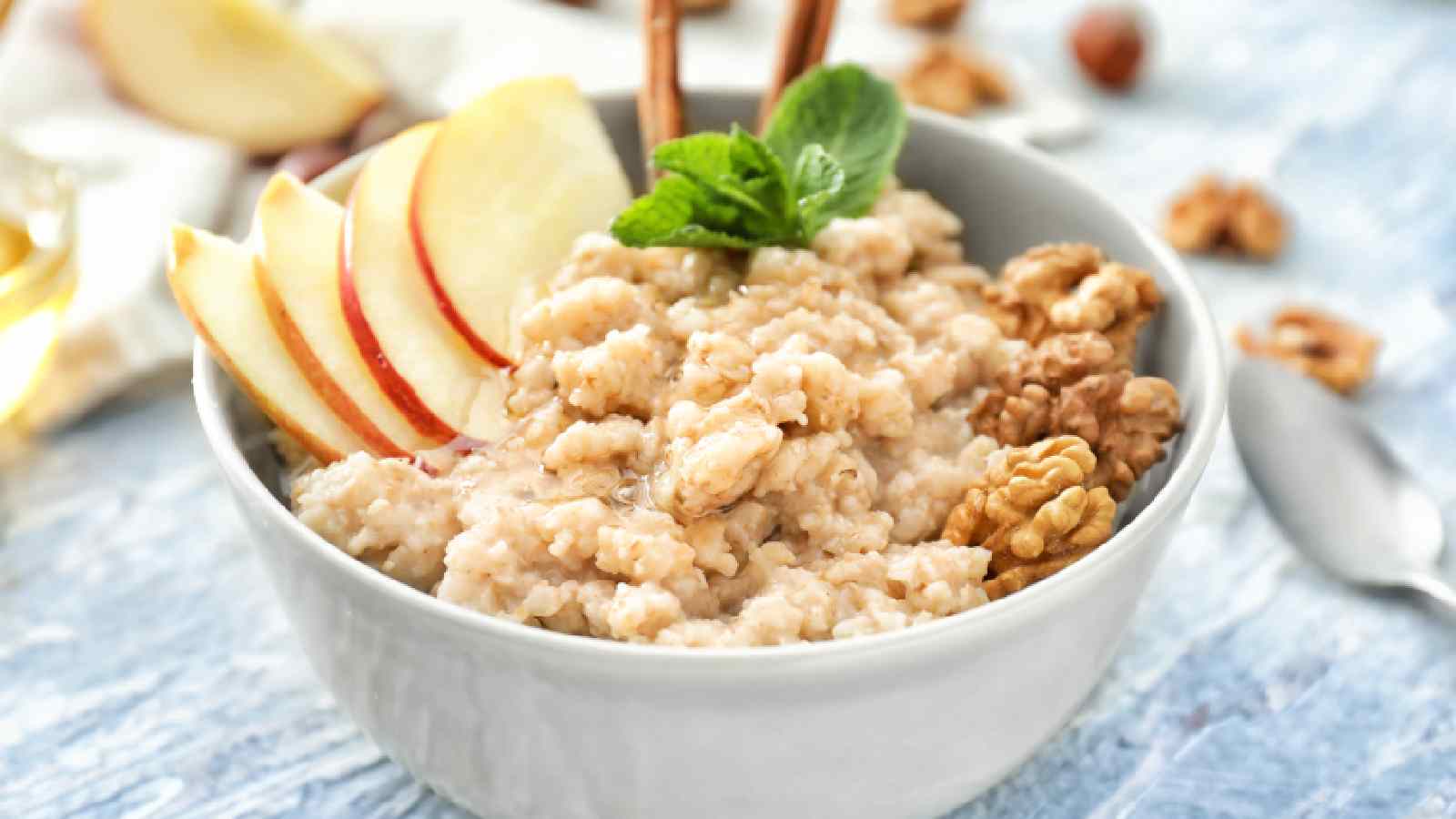Living with diabetes doesn’t mean giving up on delicious food. In fact, oats are one of the healthiest and most satisfying breakfast options for people with diabetes. They’re rich in fiber, low in sugar, and help stabilize blood sugar levels throughout the day. But the key lies in how you prepare them.
Many people unknowingly make oats unhealthy by adding too much sugar, flavored syrups, or processed toppings. The good news? With just a few smart changes, you can turn oats into a perfect diabetes-friendly meal that’s both tasty and safe.
This guide will show you how to prepare oats for diabetic patients at home easily, with simple ingredients, healthy toppings, and expert tips to keep your blood sugar under control — all while enjoying a warm, comforting bowl every morning.
Why Oats Are Good for Diabetic Patients

Rich in Soluble Fiber
The biggest reason oats are good for diabetics is their high soluble fiber content, especially beta-glucan. This fiber slows down digestion and glucose absorption, preventing sudden blood sugar spikes after meals. It helps you feel full longer, reducing cravings and supporting healthy weight management.
Low Glycemic Index
Oats have a low glycemic index (GI), especially steel-cut and rolled oats. That means they release energy slowly, keeping your blood sugar levels steady. Instant oats, however, have a higher GI, so choosing the right type of oats is crucial for diabetic-friendly meals.
Heart-Healthy Nutrients
Oats are also packed with magnesium, iron, and antioxidants that help lower bad cholesterol (LDL) and improve insulin sensitivity. Regularly eating oats can support heart health, which is especially important since people with diabetes have a higher risk of heart disease.
Types of Oats Suitable for Diabetic Patients
Not all oats are created equal. The way oats are processed affects their nutrition and impact on blood sugar. Let’s explore the best types to choose.
1. Steel-Cut Oats
Steel-cut oats are the least processed and have the lowest glycemic index among all oat types. They take longer to cook but are chewy, nutty, and ideal for diabetics. The slow digestion keeps blood sugar stable for hours.
2. Rolled Oats (Old-Fashioned Oats)
Rolled oats are steamed and flattened for quicker cooking. They’re slightly more processed than steel-cut oats but still a healthy choice for diabetic patients. Their texture is softer, and they absorb flavors well in both sweet and savory recipes.
3. Oat Bran
Oat bran is made from the outer layer of the oat grain and is packed with soluble fiber. It’s excellent for lowering cholesterol and balancing blood sugar. You can add oat bran to smoothies, yogurt, or soups to boost fiber intake.
4. Instant Oats (Use with Caution)
Instant oats cook in minutes but are often more processed and higher in GI. If you choose instant oats, go for the plain, unsweetened versions and avoid flavored packets with added sugars or syrups.
How to Prepare Oats for Diabetic Patients at Home
Step 1: Choose the Right Oats
Always pick steel-cut or rolled oats instead of instant oats. These varieties have more fiber, nutrients, and less impact on blood sugar. Store them in an airtight container to keep them fresh and free from moisture.
Step 2: Measure Properly
Stick to one serving — about ½ cup of dry oats per person. Eating too much, even of healthy foods, can still raise blood sugar. If you’re using oats as a base for a meal, balance it with protein or healthy fat for better glucose control.
Step 3: Cook with Water or Unsweetened Milk Alternatives
Avoid whole milk or sweetened almond milk, as they can add unnecessary sugar. Instead, cook oats in water, unsweetened almond milk, or oat milk. This keeps your meal light and diabetes-friendly.
Cooking method:
- Bring 1 cup of liquid (water or milk) to a boil.
- Add ½ cup oats and reduce heat.
- Simmer for 5–10 minutes (steel-cut oats may take 20–25 minutes).
- Stir occasionally until creamy.
Step 4: Skip Sugar, Use Natural Sweeteners
Never add table sugar, honey, or flavored syrups. Instead, sweeten your oats naturally with a few slices of banana, apple, or berries. These fruits contain natural sugars plus fiber, vitamins, and antioxidants that help stabilize blood sugar.
Step 5: Add Protein and Healthy Fat
Adding protein and healthy fats slows digestion, preventing sugar spikes. Try mixing in:
- A spoon of chia seeds or flaxseeds
- Unsalted nuts like almonds or walnuts
- Plain Greek yogurt for extra creaminess and protein
Step 6: Spice It Up Naturally
To make oats more flavorful without sugar, use spices like cinnamon, nutmeg, or vanilla extract. Cinnamon, in particular, may help improve insulin sensitivity and lower fasting blood sugar levels.
Healthy Oats Recipes for Diabetic Patients
1. Cinnamon Apple Oatmeal
Ingredients:
- ½ cup rolled oats
- 1 cup unsweetened almond milk
- ½ apple, diced
- ½ teaspoon cinnamon
- A handful of walnuts
Instructions:
Simmer oats and milk for 5 minutes, then stir in apples and cinnamon. Cook until tender. Top with walnuts before serving. A warm, cozy bowl that keeps blood sugar balanced.
2. Savory Oats with Vegetables
Ingredients:
- ½ cup steel-cut oats
- 1 cup water
- ½ cup chopped spinach
- ¼ cup grated carrots
- 1 boiled egg or tofu cubes
Instructions:
Cook oats in water until soft, then stir in veggies. Add salt, pepper, and herbs to taste. This savory version is full of fiber and protein — perfect for lunch or dinner.
3. Overnight Oats for Diabetics
Ingredients:
- ½ cup rolled oats
- 1 cup unsweetened almond milk
- 1 tablespoon chia seeds
- ¼ cup blueberries
Instructions:
Mix everything in a jar, refrigerate overnight, and enjoy in the morning. No cooking needed, just pure, slow-release energy to start your day right.
Tips to Make Oats More Diabetes-Friendly
Balance Carbs with Protein
Combine your oats with eggs, nuts, yogurt, or seeds. This balance helps slow the release of sugar into your bloodstream and keeps you feeling full longer.
Watch Portion Sizes
Even healthy carbs like oats can raise blood sugar if eaten in large amounts. Stick to a half-cup serving and adjust based on your doctor’s or nutritionist’s advice.
Avoid Store-Bought Instant Packets
Flavored instant oats often contain added sugars and artificial flavors. Always read the label — if sugar is listed among the first three ingredients, skip it.
Choose Low-GI Toppings
Use fruits like berries, apples, or pears, which have a low glycemic index. Avoid tropical fruits like mangoes or pineapples that may cause sugar spikes.
Add a Dash of Cinnamon
Cinnamon isn’t just for flavor — it’s a natural blood sugar regulator. Adding a sprinkle to your oatmeal can enhance taste and improve insulin sensitivity over time.
Common Mistakes to Avoid When Preparing Oats for Diabetics
Adding Too Much Sugar
This is the most common mistake. Even natural sweeteners like honey or maple syrup can increase blood sugar levels. Stick to fruits or a small pinch of stevia if you need sweetness.
Using Full-Fat or Sweetened Milk
Sweetened milk adds hidden sugar and calories. Always opt for unsweetened almond milk, soy milk, or water to keep it diabetic-friendly.
Ignoring Portion Control
A large bowl of oats might feel healthy, but overeating leads to carb overload. Remember — moderation is key.
Forgetting to Add Protein
Without protein, oats digest faster, causing blood sugar spikes. Always combine with protein or healthy fats for a balanced meal.
Best Time to Eat Oats for Diabetic Patients
The best time to enjoy oats is in the morning. A bowl of oatmeal for breakfast provides long-lasting energy and helps stabilize blood sugar throughout the day. If you prefer oats later, make sure to balance them with fiber-rich vegetables and protein.
Avoid eating oats right before bed, as your metabolism slows down, which can affect nighttime blood sugar regulation.
How Often Should Diabetic Patients Eat Oats?
Oats can be eaten three to four times a week, depending on your overall diet and blood sugar control. You can alternate between oatmeal, overnight oats, or savory oats to keep things interesting and balanced. Always consult your dietitian for personalized recommendations.
FAQs About Oats and Diabetes
Are oats safe for all types of diabetes?
Yes, oats are safe for both Type 1 and Type 2 diabetes, but portion control and preparation method are key. Always choose whole or steel-cut oats for best results.
Can I eat oats daily if I have diabetes?
Yes, but make sure your overall carb intake is balanced. Eating oats daily is fine if you combine them with protein and avoid added sugars.
Are instant oats bad for diabetics?
Instant oats aren’t necessarily bad, but they often have a higher glycemic index and added sweeteners. Stick to plain, unsweetened versions if you must use them.
What’s the best fruit to add to oats for diabetics?
Berries, apples, and pears are excellent because they’re low in sugar and high in fiber. Avoid dried fruits or fruit jams.
Can oats help lower blood sugar levels?
Yes, the beta-glucan fiber in oats helps improve insulin sensitivity and lowers post-meal glucose spikes, making it an excellent addition to a diabetic-friendly diet.
Conclusion
Learning how to prepare oats for diabetic patients at home easily can completely change how you think about breakfast. With a few simple tweaks — like choosing the right oats, avoiding added sugar, and combining with protein and healthy fats — you can create delicious meals that keep your blood sugar steady and your energy high.
Whether you prefer warm oatmeal, overnight oats, or savory veggie oats, this humble grain offers endless possibilities for healthy, satisfying meals. Consistency is key — make oats a regular part of your diet, listen to your body, and always keep moderation in mind.



